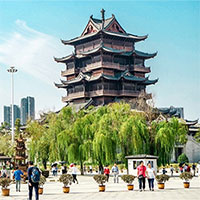According to Professor of History Matt Crawford of the University of Kent, Ohio, USA, the answer has to do with Columbus’ reputation at the time the Europeans named this newly discovered continent and the influence of the campaign. very successful campaign of the Italian explorer named Amerigo Vespucci.
The new land that the Spanish maritime explorer Christopher Columbus (1451-1506) discovered, named after the Italian cartographer Amerigo Vespucci (1454-1512) , by A. Vespucci was the first. detailed description of the land in 1507 , through famous letters in Latin gathered under the title “Quattuor Americi Vespuccij navigationes” (4 journeys of Amerigo Vespucci), according to which the new land was named after him. its own name.
Besides, until his death, Columbus maintained the opinion that the new land he discovered was Asia. Meanwhile, Vespucci was one of the first explorers to declare that the New World (present-day Americas) was an entirely new continent for Europeans.
However, there is a lot of controversy surrounding this naming. Brazilian historians believe that the name America is of local origin, from “Maroca” – the supreme god of the indigenous people of Brazil. The French scholar Francois Marcus asserted that the name was derived from the native name Los Amériques.
The French-American scientist Lamber D’Senri alone gives definitive proof that the new land that Vespucci once described is in fact already called by that name, with the names Amaraca, Ameriocapana, or Ameracapana already known. met a long time ago. While some Spanish historians are certain, that the maritime explorer Alonso de Ojeda (1468-1515) discovered the port of Maracaibo, on the coast of present-day Venezuela in 1499, and was recorded in the records. his notebook is Amriocapana…
The veteran Austrian journalist Stefan Zweig (1881-1942) in his lifetime considered the above theories as “ridiculous things from confusion”. In the mid-sixteenth century the center of European cartographic circles shifted to Germany. The young cartographer Martin Valdseemuller (1470-1520) became immortal, calling a part of Brazil (then considered an island) by the name Amerigo Vespucci through his map “Universalis Cosmographia”. universal science), commonly known as the “Wall Map of Valdseemuller” , was drawn by Martin himself at the age of 32 in 1503, and was first published in April 1507.

Statue of A. Vespucci – who had the honor of being named for the Americas – in his hometown of Florence, Italy.
New questions arose, when a group of French experts in the town of Saint-Dié near Strasbourg found Amerigo’s letters in Latin translation. The word “Amerigo” in Latin is “Alberic”. So why does M. Valdseemuller use the original Italian name of the navigator? Why did German cartographers call the new land by its own name, and not by the customary explorer A. Vespucci’s surname?
Only kings have the honor of naming places of their own! So far, no one has been able to answer this question. There was one more puzzling thing for the Spaniards, and for the British, too, for a long time refusing to call the New World the continent of America. Even in 1627, which is more than 1.3 centuries after C. Columbus discovered the Americas, the Spaniards also banned all circulating maps of America – which they called in the past the West Indies (Western Indies). India).
It was not until the end of the seventeenth century that the West Indies changed to America. Before that the whole of South America was called Peru or “Piru” (Country of gold and silver). This name was used by the discoverer of the southern Pacific Ocean, a Spaniard who was a horse breeder and avid explorer, Vasco Núnez De Balboa (1475-1519). On the relief of the portrait of the prominent Portuguese navigator Ferdinand Magellan (1480-1521), there is a Latin inscription meaning: “Ferdinand Magellan – The one who found the strait south of the land of Piru”.
The British, for their part, for a long time called America the “New World”. By the end of the sixteenth century, Indians in the eyes of Europeans were still simply ” children of nature”. So what does the name Amerigo mean, that bothers so many people?
It is a conjunction of two medieval Gothic words: Amala and Reics. “Amal” means labor-loving, sincere, willing to help others. One of the Ostrogothic kings was named Amal.
In the 6th century, Spain was handed over by King Ostrogoth Theodoric the Great (454-526) to his grandson named Amalric. And the word “Ric” or “Reics” has many meanings: strong, strong, capable, king… In that way “Amalric” combines the word “Amal” and “Ric” means hero, leader, king. After the Gothic invasion of Italy, the name began to be called a little differently.
In Italian grammar, the vowels “L” and “R” cannot stand together, so ” LR” turns into “RR”. Vespucci’s given name is written with two “Rs” : Amerigo. So why did M. Valdseemuller name the new land with only A. Vespucci’s first name with an “R” ?
Many researchers explain by the fact that in the Spanish language, such an Italian surname is very rare. A. Vespucci served the Spaniards and by that time (early sixteenth century) in Spain there was no second Florentine with his surname. So they simply call it Amerigo (on this interesting subject, foreigners have no trouble being accepted by first or last name).
Although the cartographer M. Valdseemuller’s argument is not very convincing, because he once wrote: “After Asia – Asia and Europe – Europe have taken on women’s names, so the New World must be honored with a man’s name.”
Opinions about the explorer Amerigo Vespucci began to waver in the nineteenth century, when a few scholars tried to prove that A. Vespucci had not completed his fourth voyage to the Americas. By the early 70s of the last century, this issue was turned over by French researcher Julie Markd when giving a personal opinion: the name America is derived from the Americi Indian tribes, who until At the end of the 19th century, he still lived on the shores of Lake Nicaragua.
In 1502, C. Columbus reached the “Moskitov coast” – the coast of present-day Nicaragua. When exchanging goods with the Indians, the Spaniards asked where they got their gold from? They pointed to the south and replied, “Americos,” which obviously refers to places with gold. That is the origin of the myth of American gold, forming a ” fever” that quickly spread throughout Europe.

